The Precision 5530 is the successor to Dell’s sleek, stylish and powerful Precision 5520 mobile workstation, claiming an even lighter and thinner design. The new Dell workstation has also been upgraded with impressive component options, including support for both Intel Core and the Xeon 6-core processors, the latter which will certainly add a ton of potential in the performance category. The 5530 also offers Thunderbolt type-C and HDMI 2.0 connectivity, Quadro professional graphics, and memory and storage options, making it a viable mobile workstation for a range of different applications. If you have the budget, the Precision 5530 can be outfitted to compete against most mid-to-high-end workstations on the market.
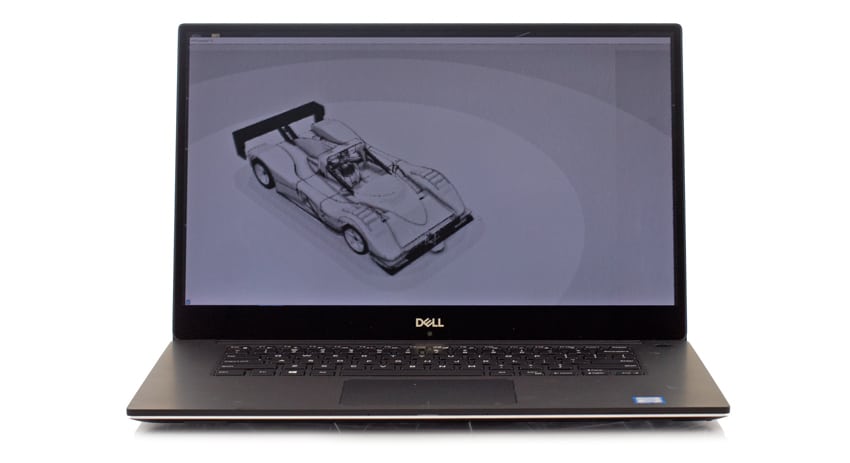
One of the biggest lures of the 5530 is its best-of-class touch display. It features up to a brilliant 15.6-inch UltraSharp UHD IGZO (3840×2160) screen with a 100% minimum Adobe color gamut. The InfinityEdge display technology with 4K PremierColor also gives users essentially a borderless viewing experience, while new IGZO 4 display features better contrast ratios and upwards of 2 hours of improved power efficiency.
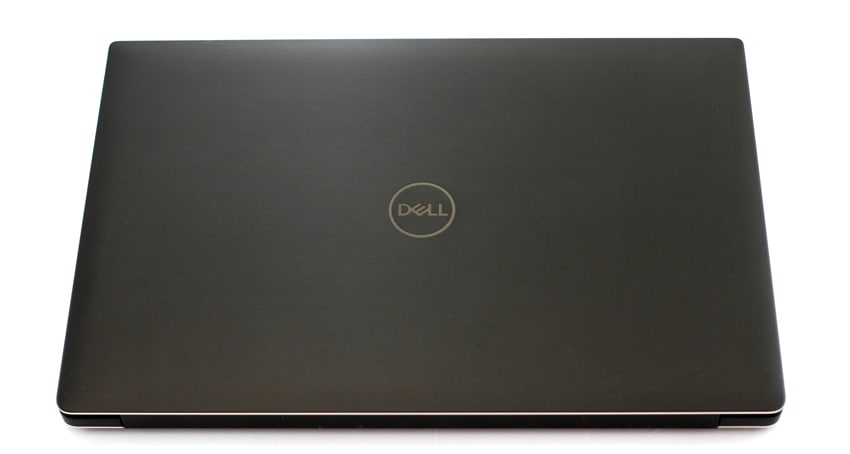
Storage options include a M.2 PCIe SSD configuration with capacities ranging from 256GB to 3TB (using both drive bays), and HDD options that range from 500GB to 2TB. Memory configurations include 8GB (2x4GB) to 32GB (16x2GB) of 2666 MHz DDR4 RAM.
Our build consists of an NVIDIA Quadro P2000, Intel Xeon E-2176M CPU (2.70GHz), 32GB DDR4 RAM and a 512GB PC400 NVMe SSD.
Dell Precision 5530 Specifications
| Processor family | Intel Xeon E-2176M (6-core 2.7GHz, 4.4GHz Turbo, 12MB 45W) Intel 8th generation Intel Core i9-8950HK,(6-core 2.9GHz, 4.8GHz Turbo, 12MB 45W) Intel 8th generation Intel Core i7-8850H (6-core 2.6GHz, 4.3GHz Turbo, 9MB 45W) Intel 8th generation Intel Core i5-8300H (4-core 2.3GHz, 4.0GHz Turbo, 8MB 45W) |
| Operating System | Microsoft 10 Windows Pro 64-bit Microsoft Windows 10 Home 64-bit Microsoft Windows 10 Pro National Academic (64-bit) Microsoft Windows 10 Home National Academic (64-bit) Microsoft Windows 10 Pro for Enterprise Microsoft windows 10 Pro for Workstation (64-bit) Red Hat Enterprise Linux (RHEL) Ubuntu 16.04 LTS SP1 64-bit |
| Chipset | Intel CM246 |
| Memory | 8GB DDR4 2666 MHz (8Gx1) 8GB DDR4 2666 MHz (4Gx2) 12GB DDR4 2666 MHz (8Gx1 + 4Gx1) 16GB DDR4 2666 MHz (8Gx2) 16GB DDR4 2666 MHz (16Gx1) 24GB DDR4 2666 MHz (16Gx1 + 8Gx1) 32GB DDR4 2666 MHz (16Gx2) |
| Graphics | Intel UHD Graphics 630 Intel UHD Graphics P630 NVIDIA Quadro P1000 NVIDIA Quadro P2000 |
| Display Options | 15.6-inch UltraSharp FHD IPS (1920×1080) Wide View Anti-Glare LED-backlit with Premium Panel Guarantee (72% color gamut) 15.6-inch UltraSharp UHD IGZO (3840×2160) Touch Wide View LED-backlit with Premium Panel Guarantee (100% Minimum Adobe color gamut) |
| Storage Options | Solid-State Drive (SSD): M.2 PCIe SSD PCIe, Up to 8 Gbps, 256 GB upto 2 TB SSD Hard drive (HDD): 2.5 inch SATA HDD, SATA , Up to 6 Gbps, 500 GB / 1 TB/ 2 TB HDD |
| Communication Options | Network adapter: Ethernet via USB-to-Ethernet Dongle provided in box. Wireless:
|
| Multimedia | Controller: Waves MaxxAudio Pro Type: Integrated Interface:
|
| I/O Ports and Connectors | Two USB 3.1 Gen 1 ports with PowerShare, One Thunderbolt 3 port (USB 3.1 Gen 2 Type-C) with power delivery, HDMI 2.0 port, Memory Card reader (SD 4.0) |
| Security | Noble lock slot Trusted Platform Module (TPM) 2.0 – Integrated on system board |
| Dimensions and Weight | Height: 17 mm (0.66 in) Width: 357 mm (14.06 in) Depth: 235 mm (9.26 in) Weight: 1.78 kg (3.93 lb) – Non Touch / 2.04 kg (4.5 lb) – Touch |
| Battery | 56 WHr lithium-ion 3 cell battery 97 WHr lithium-ion 6 cell battery |
| Power Adaptor | Type: 130W adapter Input Voltage: 100 to 240 VAC |
| Regulatory and Environmental Compliance |
EPEAT registered |
| TAA Configurations available | YES (Check regional availability) |
Design and build
The new Precision 5530 is a very nice looking mobile workstation. Users have the choice of either a platinum silver or brushed onyx design. It’s sleek, compact and weighs in at just 3.93lb for the Non-Touch version and 4.5 lb for the Touch version. Though Dell claims the 5530 is lighter than ever, the previous model was specced 3.93lbs as well. That said, we opted for the touch-screen model and it still feels very light and easy to carry around in a small laptop bag. No complaints here, as most performance-drive mobile workstations hover around the 5 pound mark.
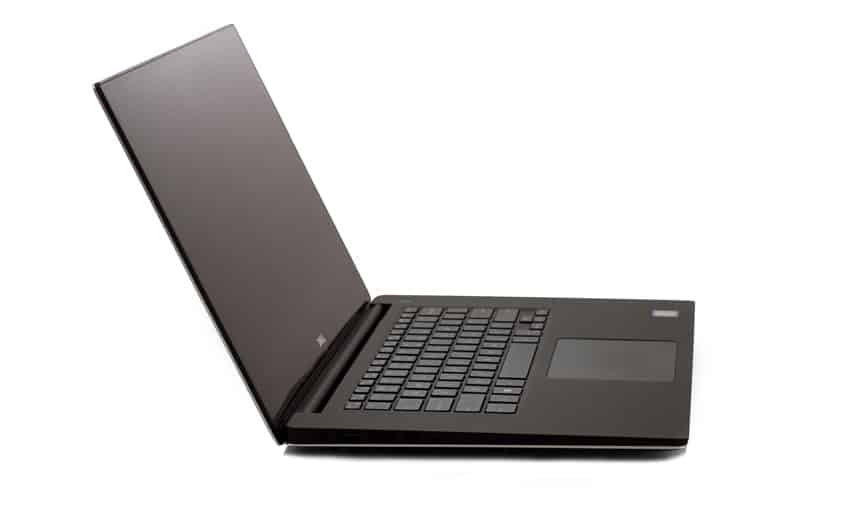
All of the 5530’s connectivity resides on the sides of the notebook. On the left is the power adapter port, a USB 3.1 Gen 1 port, an HDMI port, a Thunderbolt 3 port, and a headphone jack. The right side is home to the memory card reader, a USB 3.1 Gen 1 port and battery-status button
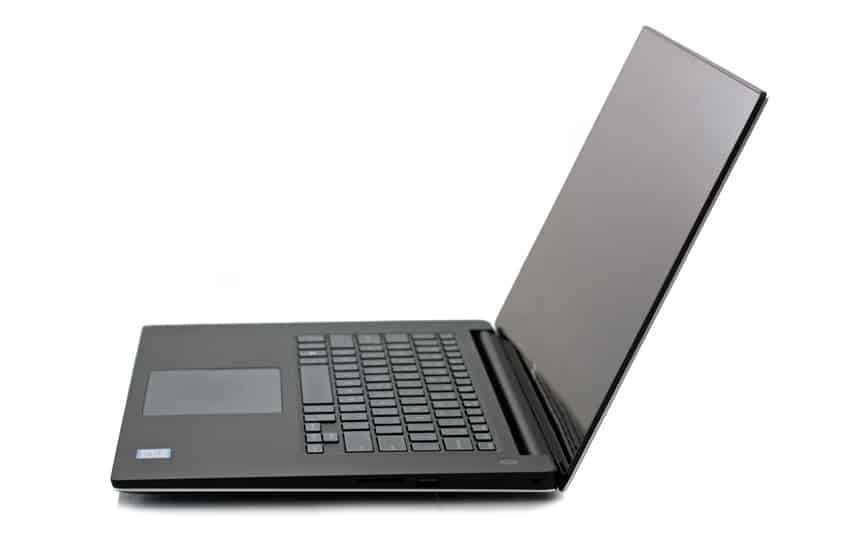
In addition to the Intel UHD integrated graphics 630/P630, you can equip the Precision 5530 with either an NVIDIA Quadro P1000 or P2000 professional graphics card. The P1000 is a entry-level card and works as a very affordable GPU solution with decent results. The P2000 is the next model up in the Quadro line and offers much of the same but with slighter better memory and bandwidth components. Though these entry-level cards are by no means on the performance-level of higher-end options (like the P6000), they do offer performance similar to cards with a much larger footprint, which helps to keep workstations as light, thin and mobile as possible without breaking the bank.
NVIDIA Quadro P1000 Specifications
- GPU Memory: 4GB GDDR5
- Memory Interface: 128-bit
- Memory Bandwidth: Up to 82GB/s
- NVIDIA CUDA Cores: 640
- System Interface: PCI Express 3.0 x16
- Max Power Consumption: 47 W
- Thermal Solution Active
- Form Factor: 2.713” H x 5.7” L, Single Slot, Low Profile Display
- Connectors: 4x mDP 1.4
- Max Simultaneous Displays: 4 direct, 4 DP 1.4
- Multi-Stream Display Resolution:
- 4x 4096×2160 @ 60Hz
- 4x 5120×2880 @ 60Hz
- Graphics APIs: Shader Model 5.1, OpenGL 4.53, DirectX 12.04 , Vulkan 1.03
- Compute APIs: CUDA, DirectCompute, OpenCL
NVIDIA Quadro P2000 Specifications
- CUDA Cores: 1024
- Peak Single Precision FP32 Performance: 3.0 TFLOPS
- GPU Memory: 5GB GDDR5
- Memory Interface: 160-bit
- Memory Bandwidth: 140 GB/s
- System Interface: PCI Express 3.0 x16
- Maximum Power Consumption: 75 W
- Energy Star Enabling: Yes
- Thermal Solution: Ultra-quiet active fansink
- Form Factor: 4.40” H x 7.90” L, Single Slot
- Display Connectors: DP 1.4 (4)
- DisplayPort with Audio: Yes
- DVI-D Single-Link Connector: Via included adapter
- Number of Displays Supported: 4
- Maximum DP 1.4 Resolution: HDR 5120 x 2880 at 60Hz (30-bit color)
- 5K Display Support: HDR 5120 x 2880 at 60Hz (30-bit color)
- 4K Display Support: HDR 4096 x 2160 at 60Hz or 3840 x 2160 at 60Hz
- Maximum DVI-D DL Resolution: 2560 x 1600 at 60Hz via 3rd party adapter
- Maximum DVI-D SL Resolution: 1920 x 1200 at 60Hz via included adapter
- HDCP Support: Yes
- Graphics APIs: Shader Model 5.1, OpenGL 4.5, DirectX 12.0, Vulkan 1.0
- Compute APIs: CUDA, DirectCompute, OpenCL
- Warranty: 3 Years
Performance
To see what the Precision 5530 is capable of in resource-intensive environments, we put it through three specific benchmarks with the given components of its Intel Xeon E-2176M CPU (2.70GHz), 32GB DDR4 RAM and a 512GB PC400 NVMe SSD. These tests will also show the capabilities of the Quadro P2000 when inside the Precision 5530. We’ve also compared it to the following workstations:
Note that the 5520 is equipped with a higher-end professional graphics card (NVIDIA Quadro P3200 vs. a P2000) than the 5530.
This first test is the SPECviewperf 12 benchmark, which is the worldwide standard for measuring graphics performance based on professional applications. SPECviewperf runs 9 benchmarks called “viewsets,” which represent graphics content and behavior from actual applications and include categories such as 3D Max, CATIA, Creo, Energy, Maya, Medical, Showcase, Siemens NX, and Solidworks.
| SPECviewperf 12 | |||
|---|---|---|---|
| Viewsets | Precision 5530 | Dell Precision 7530 | Dell Precision 5520 |
| 3dsmax-05 | 71.99 | 103.66 | N/A |
| catia-04 | 68.22 | 122.13 | 21.55 |
| creo-01 | 64.83 | 109.82 | 19.29 |
| energy-01 | 6.36 | 11.03 | 0.45 |
| maya-04 | 13.53 | 58.53 | 22.22 |
| medical-01 | 27.89 | 52.50 | 7.77 |
| showcase-01 | 30.40 | 59.66 | 14.18 |
| snx-02 | 64.73 | 122.59 | 26.73 |
| sw-03 | 102.33 | 139.67 | 33.4 |
The Precision 5530 recorded some pretty solid results, showing significant gains over its predecessor in most of the categories.
Our next benchmark is SPECwpc test, which is designed for gauging all of key aspects of workstation performance. It consists of over 30 workloads related to CPU, graphics, I/O, and memory bandwidth. The workloads fall under broader categories, such as media and entertainment, financial services, product development, energy, life sciences, and general operations, which are an average of all the individual workloads in each category. The Dell Precision 5530 posted the following results when equipped with a Quadro P2000.
| SPECwpc v2.0 | |||||
|---|---|---|---|---|---|
| Category | Precision 5530 | Dell Precision 7530 | Dell Precision 5520 | ||
| M&E | 2.79 | 2.92 | 2.25 | ||
| ProdDev | 2.76 | 3.05 | 2.21 | ||
| LifeSci | 2.84 | 3.25 | 2.35 | ||
| Energy | 3.02 | 3.36 | 2.17 | ||
| FSI | 3.38 | 4.57 | 2.99 | ||
| GeneralOps | 1.29 | 1.29 | 1.33 | ||
Here, the Precision 5530 continued to show off more gains over the 5520, while the 7530 shows what a best-of-class performer can do.
Our last test is the ESRI benchmark where we look at several aspects of the ArcGIS program. Here, we are most interested in the average of the drawtime, average frames per second (Average FPS), and minimum frames per second (Minimum FPS). Looking at drawtime, the Dell Precision 5530 showed an average drawtime of 0:10.769, while average and minimum FPS showed 135.69 and 45.89, respectively.
| ESRI Benchmark | |
|---|---|
| Drawtime | Average |
| Dell Precision 5530 | 00:00:10.769 |
| Dell Precision 7530 | 00:00:09.925 |
| Dell Precision 5520 | 0:00:09.94 |
| Average FPS | Average |
| Dell Precision 5530 | 135.69 |
| Dell Precision 7530 | 157.33 |
| Dell Precision 5520 | 99.14 |
| Minimum FPS | Average |
| Dell Precision 5530 | 45.89 |
| Dell Precision 7530 | 51.33 |
| Dell Precision 5520 | 53.60 |
Conclusion
The 5530 lies in the middle of Dell’s Precision line of mobile workstations, boasting solid mid-range performance across the board when outfitted with some of the higher-end components available. Among these components include a 8th Gen Intel Core and Xeon 6-core processor options, NVIDIA Quadro professional GPUs, up to a 32GB of DDR4 RAM, and a 256GB M.2 NVMe PCIe SSD. Users can also add another drive if they choose.
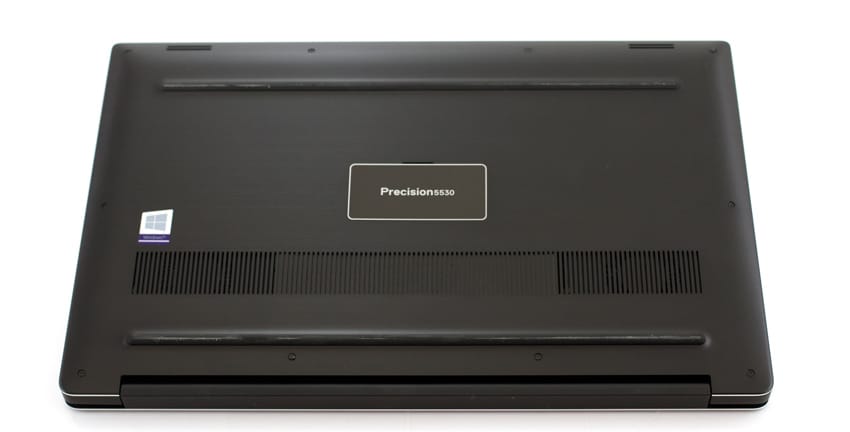
Diving into performance details shows some decent numbers from the Precision 5530 during our graphics-intensive SPECviewperf, SPECwpc, and ESRI benchmarks. In our SPECviewperf test, the 5530 showed a significant performance gain over the previous model (5520) even though it featured a lower-end graphics card. This was particularly noticeable in the Creo and Solidworks categories. This performance continued in our SPECwpc (which tests CPU, graphics, I/O, and memory bandwidth) benchmarks, though the 5520 did have a better average drawtime and minimum FPS score in our ESRI (ArcGIS program) benchmarks.
Overall, the 5530 is a strong addition to the Precision portfolio of premium mobile workstations, and you will see performance good enough to suit a range of professional needs even with a mid-range component build. Professionals looking to take the 5530 to the next level and are willing to fork over an additional $2,500 to $6,000 for the P5000 and P6000, respectively, will be able to make this a serious performance-driven notebook. These aren’t part of the standards builds, so you will receive these separately and will have to install them yourself.




 Amazon
Amazon